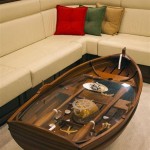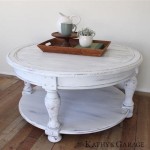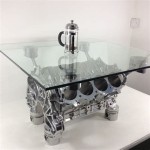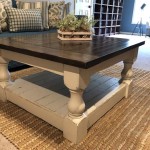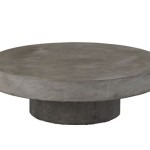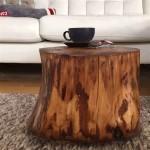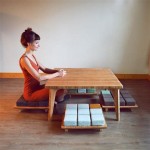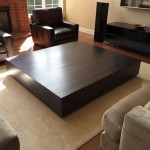How Big Should A Coffee Table Be Compared To A Sofa Bed?
Selecting the correct size coffee table for a living space featuring a sofa bed is a crucial design decision that impacts both aesthetics and functionality. Unlike a traditional sofa, a sofa bed often serves multiple roles: primary seating, occasional guest sleeping space, and sometimes even a secondary workspace. This multifaceted nature necessitates careful consideration when choosing a coffee table to complement it. The dimensions of the coffee table should be proportional to the sofa bed's size and height in its seating configuration, while also allowing for comfortable movement and access around the extended bed configuration.
The primary factors that influence the ideal coffee table size relative to a sofa bed include the sofa bed's length, depth, and height as a sofa, as well as the available floor space in the room. A coffee table that is too large can overwhelm the room and hinder movement, while a coffee table that is too small may appear insignificant and fail to provide adequate surface area for practical use. Furthermore, the chosen coffee table style and design should harmonize with the overall décor of the room and the sofa bed's aesthetic.
Key Point 1: Determining the Ideal Length and Width
The length of the coffee table is arguably the most critical dimension to consider. A general guideline is that the coffee table should be approximately two-thirds the length of the sofa bed. This proportion creates a visually balanced arrangement and ensures that the coffee table is easily accessible from all seating positions on the sofa. For instance, if the sofa bed is 72 inches long (6 feet), the ideal length for the coffee table would be around 48 inches (4 feet). This calculation is derived by multiplying the sofa length by 0.66 (two-thirds). It's important to measure the actual seating area of the sofa bed rather than the overall frame length, as armrests can add to the total length without necessarily increasing the usable seating space.
The width of the coffee table is equally important. It should be sufficient to provide ample surface area for placing drinks, books, remote controls, or decorative items, without obstructing movement around the room. A good rule of thumb is to ensure that there is at least 12 to 18 inches of space between the edge of the coffee table and the sofa bed. This clearance allows for comfortable legroom and prevents anyone from feeling cramped while seated. If the room is smaller, prioritizing the 12-inch clearance is crucial for maintaining ease of movement. In larger rooms, increasing this distance to 18 inches or more can enhance the sense of spaciousness.
Furthermore, the width of the coffee table should also be proportionate to its length. A coffee table that is excessively wide compared to its length may appear bulky and disrupt the visual harmony of the room. A common guideline is to keep the width approximately one-half to two-thirds of the length. For example, if the coffee table is 48 inches long, the width could range from 24 to 32 inches. This ratio helps to create a balanced and aesthetically pleasing appearance.
When the sofa bed is converted into a bed, the positioning of the coffee table might need adjustments. A coffee table with wheels offers versatility, allowing easy relocation to the side of the room or another area when the sofa bed is in sleeping configuration. Alternatively, smaller, lightweight coffee tables can be easily lifted and moved as needed. The ability to reposition the coffee table ensures that it does not obstruct access to the bed and that it can still serve a functional purpose, such as holding bedside essentials.
Key Point 2: Height Considerations for Comfort and Functionality
The height of the coffee table is another significant factor that influences its usability and overall comfort. A coffee table that is too high can be awkward to use while seated on the sofa bed, while a coffee table that is too low can be difficult to reach. Ideally, the coffee table should be approximately the same height as the sofa bed's seat cushion, or slightly lower. This allows for easy access to items placed on the coffee table without requiring excessive bending or reaching.
The standard height for a coffee table is typically between 16 and 18 inches. However, the ideal height may vary depending on the specific dimensions of the sofa bed. To determine the optimal height, measure the distance from the floor to the top of the sofa bed's seat cushion. The coffee table should be within a few inches of this measurement. If the sofa bed has a particularly low seating height, a slightly lower coffee table may be more comfortable. Conversely, if the sofa bed is higher than average, a slightly taller coffee table may be appropriate.
In situations where the sofa bed doubles as a dining or workspace, a coffee table with an adjustable height mechanism can be a valuable addition. Adjustable coffee tables allow the user to raise or lower the tabletop to a more convenient height for eating, working, or other activities. These tables often feature a lift-top design that provides a stable and elevated surface when needed, and can be lowered to a standard coffee table height when not in use. This adaptability makes them particularly well-suited for smaller living spaces where furniture needs to serve multiple purposes.
Furthermore, consider the leg style and overall design of the coffee table. Coffee tables with thicker legs or a more substantial base may appear visually heavier and can potentially make the room feel smaller. Conversely, coffee tables with slender legs or an open base can create a sense of airiness and spaciousness. Choosing a coffee table with the appropriate leg style can help to enhance the overall aesthetic of the room and prevent the coffee table from overwhelming the space.
Key Point 3: Material, Style, and Room Aesthetics
Beyond dimensions, the choice of material and style for the coffee table should complement the sofa bed and the overall décor of the room. The material of the coffee table significantly impacts its durability, maintenance requirements, and visual appeal. Common coffee table materials include wood, glass, metal, and stone, each offering distinct advantages and disadvantages.
Wooden coffee tables are a classic choice, offering warmth, durability, and versatility. They can be stained or painted to match a wide range of décor styles, from traditional to contemporary. However, wooden coffee tables can be susceptible to scratches and water damage, requiring regular maintenance to keep them looking their best. Glass coffee tables offer a sleek and modern aesthetic, creating a sense of openness and light. They are easy to clean and maintain, but can be prone to fingerprints and smudges. Metal coffee tables are known for their durability and industrial-chic appeal. They are often made from steel or iron, and can be powder-coated in a variety of colors. Stone coffee tables, such as marble or granite, offer a luxurious and sophisticated look. They are highly durable and resistant to scratches and stains, but can be heavy and expensive.
The style of the coffee table should also be carefully considered. A coffee table with clean lines and a minimalist design may be well-suited for a modern or contemporary living space. A coffee table with ornate details and a traditional design may be a better fit for a more formal or classic décor. It is essential to choose a coffee table that complements the style of the sofa bed and the other furniture in the room.
The overall aesthetics of the room also play a role in determining the ideal coffee table size and style. In smaller rooms, opting for a coffee table with a glass top or a light-colored finish can help to create a sense of spaciousness. In larger rooms, a larger coffee table with a darker finish may be more appropriate. Consider the existing color palette and textures in the room, and choose a coffee table that harmonizes with these elements. A well-chosen coffee table can serve as a focal point in the room, tying together the various design elements and creating a cohesive and inviting space. Consider the room's traffic patterns. If the room is frequently used, prioritize function and durability. If the room is primarily for show, aesthetic considerations may take precedence.
Ultimately, selecting the right coffee table for a sofa bed involves a careful balancing act between functionality, aesthetics, and practicality. By considering the sofa bed's dimensions, the available floor space, and the overall décor of the room, individuals can choose a coffee table that enhances the living space and provides a comfortable and stylish focal point.
:strip_icc()/cdn.cliqueinc.com__cache__posts__268833__how-to-choose-a-coffee-table-268833-1538077811019-image.700x0c-7a56fb07e0084a48b51032071b7fa87b.jpg?strip=all)
Don T Make This Living Room Coffee Table Mistake

How To Choose A Coffee Table Guide Crate Barrel

How Far Should A Coffee Table Be From Sofa 2024 Edition 2modern

5 Ways To Know What Size Coffee Table For Sectional Here S How

How Long Should A Coffee Table Be For Sofa Your Complete Guide To Perfect Proportions Petalwood Interiors
.png?strip=all)
How To Choose The Right Size Of Coffee Table For My Space

How To Arrange An Ottoman Coffee Table Transformer

Which Coffee Table Suits Your Sofa Dreieck Design

Which Coffee Table Suits Your Sofa Dreieck Design

Which Coffee Table Suits Your Sofa Dreieck Design
Related Posts

